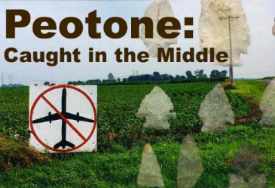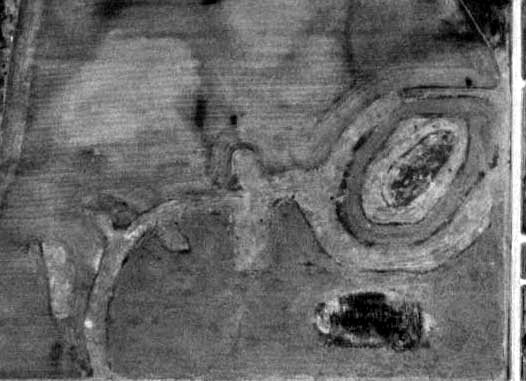 |
|
|
|
|
 While using aerial photos in preparation for use in site registration,
I came across this geometric pattern. I checked the preliminary archaeological
survey but could find no
I was later told that this was a natural formation but I couldn't quite
buy that story.
Tim Good, of the forest preserve, and I presented the facts to the Will County Historic Preservation Commission in early December of 2001 and they are also following this subject. Joseph Standing Bear Schranz, President of Midwest Soarring Foundation, a Native American group that saves human remains and resources, came out to look at this anomaly early in the spring of 2001 and he, in turn, sent out his mound expert to take a look at the site. It is both Joseph's and Jim Marshall's (mound expert) opinion that this is clearly a ceremonial mound. They have both stated that they are 100% certain that the anomaly is man-made. Several local archaeologists that have also walked this field agree that this is a mound. Joseph believes this is an effigy mound in the shape of a stylized animal. He says there is meaning to each one of these mounds and he would like to see it protected. At one time there was a similar structure east of Crete, Illinois and my uncle, Robert Buchanan, has always talked about it. The structure was destroyed when a large highway was constructed. We don't want to see a repeat of that scenario and that is why Joseph decided to make this structure public knowledge, basically in hopes of saving it from destruction. Note the dark ovate shape at the bottom right of the photo. We believe
this depression to
Another interesting fact is that a large village site (115 acres) was recorded in 1934 by George Neumann and R. M. Snodgrass. At the time it was described as a "village" consisting of "a series of depressions about 10 feet in diameter, 18 inches deep, the largest of which was about 45 feet in diameter and 2 to 2.5 feet deep". The assemblage reported from the site included a Red Ochre point or knife, Woodland points, polished slate gorgets and "pick-like objects", celts, axes and a glazed earthen bottle. The present survey of 1995-1996 documented a number of sites within this area so the "village" site was redefined to pertain to only one small site location. This area lies west of the anomaly by about one and a half miles. According to the survey report, further work is recommended at the "village" site. Interesting set of circumstances I would say. |
|
To the Table Of Contents |